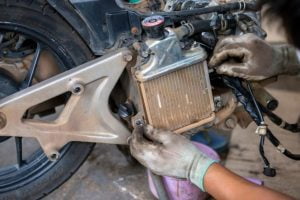First-time bikers may find it challenging to keep their rides cool. In some cases, they may panic and immediately call a motorcycle mechanic. On the other hand, if the bikers continuously ignore signs of overheating, more complicated problems may arise. These issues may lead to warping and swelling of the engine block and head, leading to significant damage.
Suppose you’ve just learned how to ride your motorcycle. In that case, you may need to know how to keep your bike well-maintained. This includes keeping your engine cool to avoid overheating. For that purpose, here are some tips to guide you. So, read on!
- Install An EGT Sensor
Installing a top-of-the-line exhaust gas temperature (EGT) sensor is the first step to keeping your engine cool. This device doesn’t just measure the temperature of the engine exhaust gas. It also indicates if the heating reaches dangerous levels.
Generally, the sensor sends information to the engine control unit (ECU), where it tries to reduce the temperature by decreasing boost pressure after receiving an appropriate warning.
Without a proper EGT sensor, inappropriate or lacking information may be sent to the ECU, leading to an untimely lowering of temperature. In replacing an EGT sensor, you may consider installing products that could withstand 800°C and above such as REP EGT Sensors.
- Set Up The Carburetor
If your engine has too little fuel or too much air in the mixture, the engine may overheat. This situation generally slows down the ignition and prolongs the combustion, resulting in overheating of the components.
To prevent a lean setup, you should ensure the mixture is properly mixed—a balanced air and fuel mixture. In addition, synchronizing the carburetor can help slow the temperature increase of the liquid and components.
- Use The Right Coolant
The ultimate purpose of coolants is to transfer heat away from the engine. In most cases, this substance comes in liquid and gas forms that you can pour into engines to prevent water from overheating. Leaking coolant may also result in a quick temperature rise as its absence increases the chance of heating water and engine.
When choosing a coolant, consider its thermal capacity and viscosity. High-thermal coolants can keep the engine cool even in extreme temperatures, while less dense types could prevent material buildup in the fluids that may aggravate heating.
- Change The Engine Oil At Regular Intervals
If your engine oil’s level is way below usual standards, your engine tends to heat up more quickly. To avoid this, you may need to check your engine oil to see if it’s within the right level. More importantly, you should replace the engine oil at regular intervals.
Older engines may require more frequent oil replacement since they consume more oil than newer ones. They’re also more prone to leaks and spills, so you need to run maintenance checks for old motorcycles more frequently.
The rule of thumb is to replace your engine oil every 3,000 kilometers. You may also think about using high mileage oil if you plan to travel on straight and smooth terrain for an extended period. You may also look into the recent motorcycle trends that could benefit your bike.
- Normalize Having Stops When Riding For Extended Periods
Whether you’re riding a brand-new or your trusty motorcycle, stopping may be necessary to avoid overheating. In many cases, riding the bike for an extended time can heat your engine fast. If your fluids are low, the rate of spiking temperature may double. To avoid this, you have to stop riding until the engine has recovered enough.
During your stops, you can maximize your rest by checking the usual heat indicators of your bike. If your EGT sensor is working well, you can directly inspect the carburetor settings and other engine setups.
You may also listen to the produced sound of your engine when you’re riding, as loud and unusual sounds are typical signs of overheating and other motorcycle engine issues.

- Fix Faulty Radiator And Fan
Faulty radiators and fans may fail to circulate the coolant, which could address overheating issues. Fixing these parts could make them functional again, thus distributing the coolant better. The coolant carries the heat away, and if the substance hasn’t been appropriately moved, it could affect the engine parts where it’s stocking up.
In most cases, you may need to remove the dust, grime, and gunk that accumulated in the radiator, mainly if the bike hasn’t been used for a long time. If the fans are covered with dirt, you may clean them appropriately with a soft broom or fabric to make the fans work again.
Wrapping Up
One of the ways to keep your bike properly maintained is by keeping its engine cool. If you want to keep the engine from overheating, consider applying the tips mentioned in this article. In addition, you may ask a seasoned bike mechanic for some hacks to help you keep your bike’s engine cool for an extended time.


















